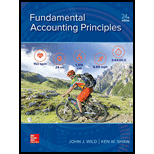
Concept introduction:
Cost Flow from Inventory to Cost of Goods Sold
Cost Flow refers to methods available for moving the companys product cost from Inventory to Cost of Goods Sold. Methods include FIFO and LIFO. Under FIFO, Cost of goods sold would be purchase price of Goods Purchased earlier. Under LIFO cost of goods sold would reflect goods purchased later.
To discuss:
The flow of cost from Inventory to Cost of Goods sold under FIFO and LIFO with appropriate examples
Explanation of Solution
FIFO(First In First Out) Method:
Under FIFO, Cost of Goods sold will comprise of costs which were undertaken earlier by the company on purchase of a product, and inventory will reflect the cost at its current price. Eg. If a product is purchased at prices of $45, $47 and $48, Cost of goods sold will be valued at $45 and $47, whereas Ending Inventory will be valued at $48. It can be demonstrated as below:
Income Statement
Net Sales .$200
(-)COGS ..$92($45+$47)
Gross Profit .$108
Inventory .$48
LIFO(First In First Out) Method:
Under LIFO, Cost of Goods Sold will comprise of costs which are most recent and inventory will reflect earlier prices of the product. Eg. If a product is purchased at prices of $45, $47 and $48, Cost of goods sold will be valued at $48 and $47, but inventory will be $45. It can be demonstrated as below:
Income Statement
Net Sales .$200
(-)COGS ..$95($47+$48)
Gross Profit .$105
Balance Sheet
Inventory .$45
Want to see more full solutions like this?
Chapter 6 Solutions
Fundamental Accounting Principles
- Ankit's Manufacturing has a total contribution margin of $75,600 on sales of $180,000. Their fixed costs amount to $43,200 per month. If sales were to increase by 15% without any change in fixed costs or contribution margin ratio, what would be the new monthly operating income? Calculate this using the contribution margin approach.arrow_forwardThe cost of goods sold for February wasarrow_forwardKayla Enterprises has sales of 45.8 million, total assets of 37.2 million, and total debt of $12.7 million. If the profit margin is 9 percent, what is the net income?arrow_forward
- Please provide the answer to this general accounting question with proper steps.arrow_forwardCan you solve this general accounting problem with appropriate steps and explanations?arrow_forwardPlease provide the correct answer to this general accounting problem using accurate calculations.arrow_forward
- Can you help me solve this general accounting problem with the correct methodology?arrow_forwardWhy does measurement attribute selection affect reporting quality? A. Standards fit everything B. Different value bases serve varying information needs C. Selection wastes time D. Single measures work universally need helparrow_forwardCan you explain the correct methodology to solve this general accounting problem?arrow_forward

 AccountingAccountingISBN:9781337272094Author:WARREN, Carl S., Reeve, James M., Duchac, Jonathan E.Publisher:Cengage Learning,
AccountingAccountingISBN:9781337272094Author:WARREN, Carl S., Reeve, James M., Duchac, Jonathan E.Publisher:Cengage Learning, Accounting Information SystemsAccountingISBN:9781337619202Author:Hall, James A.Publisher:Cengage Learning,
Accounting Information SystemsAccountingISBN:9781337619202Author:Hall, James A.Publisher:Cengage Learning, Horngren's Cost Accounting: A Managerial Emphasis...AccountingISBN:9780134475585Author:Srikant M. Datar, Madhav V. RajanPublisher:PEARSON
Horngren's Cost Accounting: A Managerial Emphasis...AccountingISBN:9780134475585Author:Srikant M. Datar, Madhav V. RajanPublisher:PEARSON Intermediate AccountingAccountingISBN:9781259722660Author:J. David Spiceland, Mark W. Nelson, Wayne M ThomasPublisher:McGraw-Hill Education
Intermediate AccountingAccountingISBN:9781259722660Author:J. David Spiceland, Mark W. Nelson, Wayne M ThomasPublisher:McGraw-Hill Education Financial and Managerial AccountingAccountingISBN:9781259726705Author:John J Wild, Ken W. Shaw, Barbara Chiappetta Fundamental Accounting PrinciplesPublisher:McGraw-Hill Education
Financial and Managerial AccountingAccountingISBN:9781259726705Author:John J Wild, Ken W. Shaw, Barbara Chiappetta Fundamental Accounting PrinciplesPublisher:McGraw-Hill Education





